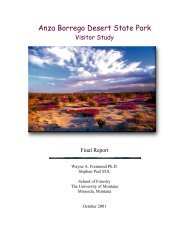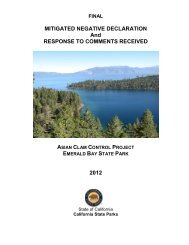Draft EIS/EIR for the San Luis Reservoir SRA Resource ...
Draft EIS/EIR for the San Luis Reservoir SRA Resource ...
Draft EIS/EIR for the San Luis Reservoir SRA Resource ...
You also want an ePaper? Increase the reach of your titles
YUMPU automatically turns print PDFs into web optimized ePapers that Google loves.
5. Environmental Analysis<br />
Table 5-1<br />
Future Criteria Pollutant Emissions from Plan Area Visitation (2040)<br />
Type CO VOC NO x PM 10 PM 2.5 SO 2<br />
Vehicle Emission Factors<br />
(lb/mi)<br />
Vehicle Emissions<br />
(tons/yr)<br />
Boat Emission Factors<br />
(ton/boat)<br />
Evap Boat Factors<br />
(tons/boat)<br />
0.0135 0.0013 0.0012 8.42252E-05 5.23E-05 9.00E-06<br />
12.744 1.248 1.158 0.079 0.049 0.008<br />
0.00037 1.97E-04 1.80E-05 2.59E-05 2.59E-05 4.48E-08<br />
2.71E-05<br />
Boat Emissions (tons/day) 0.01922 0.01171 0.00094 0.00135 0.00135 0.00000<br />
Boat Emissions<br />
(tons/year)<br />
Total Emissions<br />
(tons/year)<br />
7.02 4.28 0.34 0.49 0.49 0.00<br />
19.764 5.524 1.500 0.574 0.544 0.009<br />
SJVAPCD Thresholds<br />
(tons/year) NA 10 10 15 15 NA<br />
GCR De Minimis Levels<br />
(tons/yr) Attainment 10 10 100 100 Attainment<br />
As shown in Table 5-1, future total emissions from <strong>the</strong> Plan Area would remain<br />
well below <strong>the</strong> SJVAPCD thresholds (where thresholds exist) and GCR de<br />
minimis levels. No exceedances would occur if Plan Area motor vehicle and<br />
vessel use doubled. Motor vehicle and vessel use would have to quadruple be<strong>for</strong>e<br />
a single threshold (<strong>for</strong> VOC) would be exceeded; all o<strong>the</strong>r criteria emissions<br />
would remain below SJVAPCD thresholds and GCR de minimis levels. Although<br />
automotive and boat traffic would likely vary among <strong>the</strong> four alternatives, a<br />
quadrupling in future motor vehicle and vessel use in <strong>the</strong> Plan Area is unlikely to<br />
occur. None of <strong>the</strong> alternatives would result in levels of park visitation high<br />
enough to create heavy and sustained traffic patterns that would produce major air<br />
quality issues. The indirect effects of increasing vehicle traffic in <strong>the</strong> region from<br />
Plan implementation would result in only a minor increase in total vehicular<br />
emissions in <strong>the</strong> area.<br />
In addition, new regulations are expected to reduce air emissions as motorized<br />
vehicle and vessel manufacturers improve <strong>the</strong>ir technology to meet emission<br />
standards. As described in Section 2.5, all marine outboard and personal<br />
watercraft engines manufactured in 2008 or later are required to comply with<br />
Cali<strong>for</strong>nia Air <strong>Resource</strong>s Board (CARB) 2008 exhaust emission standards <strong>for</strong><br />
hydrocarbons and NO x . All marine outboard and personal watercraft engines<br />
manufactured in 2010 or later will be required to comply with USEPA 2008<br />
emission standards (USEPA 2008a), and spark-ignition marine vessel engines<br />
from 2012 and later will be required to comply with CARB and USEPA standards<br />
<strong>for</strong> evaporative emissions (CARB 2010c). Regulations regarding GHG emissions<br />
from motor vehicles (see below under “Greenhouse Gas Emissions”) would also<br />
reduce criteria pollutant emissions.<br />
<strong>San</strong> <strong>Luis</strong> <strong>Reservoir</strong> <strong>SRA</strong> 5-19<br />
<strong>Draft</strong> RMP/GP and <strong>Draft</strong> <strong>EIS</strong>/<strong>EIR</strong>
















